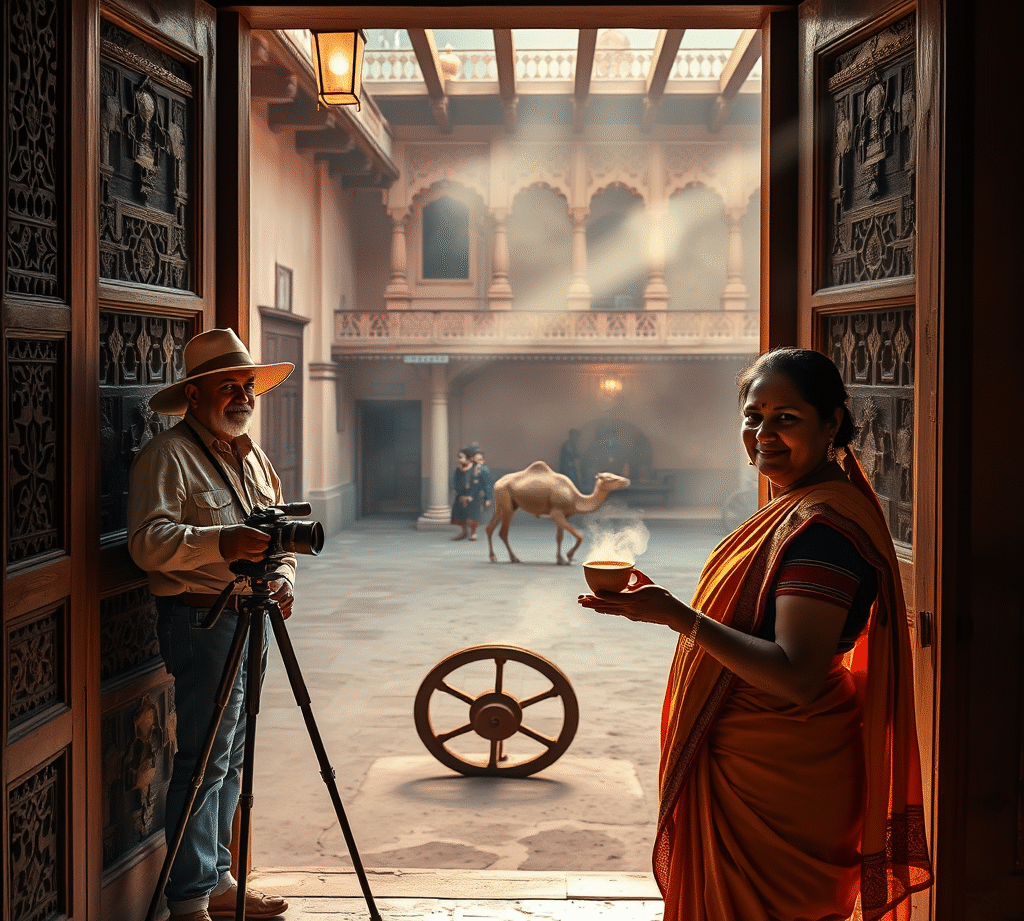Mastering Indian Travel Photography
1. The Allure of India for Photographers
Feature
Why It Matters
| Feature | Why It Matters |
|---|---|
| Abundant heritage sites – 100+ forts & palaces | Each stone keeps a story, giving endless frames. |
| Seasonal extremes – monsoons, desert heat | From misty calm to scorching glare, every lighting adventure. |
| Cultural mosaic – Hindu, Muslim, tribal, cosmopolitan | Rich stories about rituals, attire, daily life. |
| Iconic color schemes – Rajasthani weddings, Kerala backwaters | Hues that make your palette pop. |
| Local hospitality – Friendly, open to being photographed | Easier permissions, more candid moments. |
Takeaway: The mix of architecture, weather, and people turns India into a real‑time laboratory for creative exploration.
2. Heritage‑to‑Hotel Storytelling
2.1 The Rising Trend Old forts and palaces have sprouted new skins as boutique hotels—think the Amber Fort Hotel in Jaipur or the Udaipur Palace Resort. They invite you to stay among living museums. Airbnb calls them “heritage havens” and they often keep open their secrets.
2.2 How to Capture Them
| Shot Idea | Why It Works | Tips |
|---|---|---|
| Exterior at dusk | Golden hour warms stone, adds drama | Tripod + ND filter if you want a silky sky |
| Lobby opulence | Wide room shows carved ceilings | Grab a wide‑angle lens; don’t cut off the grand doors |
| Room with a view | A courtyard framed by framed windows feels inviting | Add a rug or a vase to give depth |
| Local interaction | The warmth in a smile or a handshake brings humanity | Seek permission, stay candid and relaxed |
Pro Advice: Ask the staff for the “signature” spots. A few friendly “yes”es can earn you an unmatched tea shot in their café.
3. Rural Rajasthan – The Heartbeat of the Desert
| Visual | Cultural Significance | Photographing Tips |
|---|---|---|
| Ox‑driven water wheel turning slowly | Shows eternal rhythm of work | Use motion blur to capture the wheel’s pulse |
| Camel carts crossing dusty roads | A 18th‑century trade relic | Tight‑up lens compresses and makes the scene dramatic |
| Manual threshing & ox‑ploughing | Hands‑on farming, raw resilience | Snap close‑ups of muddy hands, then wide shots of the fields |
3.1 Ethical Frame
– Patience – Great shots come from watching, not forcing.
– Reciprocity – A few rupees or a small gift goes a long way.
Case Study: In Jodhpur, a photographer lingered beside a farmer all morning to capture life unfiltered and true.
4. Color & Light: From Festive Hues to Monsoon Mists
| Season | Palette | Mood | Shooting Technique |
|---|---|---|---|
| Rajasthani Spring | Bright reds, saffron, gold | Joyful | Low ISO, add a gentle flash for dim interiors |
| Monsoon (Southern India) | Soft blues, white mist | Melancholic | Polarizer cuts haze; front lighting deepens shadows |
| Summer (Desert) | Dusty oranges, beige | Heat, starkness | Shoot early in the morning; wide‑angle laches horizon |
Key Lessons
– Light is a storyteller, not a backdrop.
– Anchoring your composition in the dominant color—like a saffron saree against a mustard backdrop—draws the eye organically.
5. Film Photography Workflow in India
5.1 Gear Checklist
| Item | Why It’s Essential |
|---|---|
| Pentax 67II | Medium‑format depth, lush tone |
| 45mm, 75mm & 105mm lenses | Versatile for portraits and street |
| Expired 400–1200 ISO films | Adds character, saves money |
| Dip & Dunk kit | Creates a selective color or vintage feel |
| Fuji Frontier SP3000 & Imacon 646 | Scanning clarity & wide dynamic range |
| Nikonos V + SB‑105 strobe | Quick bursts for low‑light moments |
Tip: Keep two rolls of expired film and one fresh roll packed—so you can test texture on the fly.
5.2 Workflow Steps
1. Loading – Check the ISO and make sure the shutter clicks.
2. Shooting – Include a meter reading in the frame for later tweaks.
3. Develop – Dip & Dunk gives a layered feel.
4. Scan – Fuji for sharp detail; Imacon for larger negatives.
5. Print – Print locally in A3 or in a small lab for best quality.
6. Catalog – Tag by GPS, film type, and a quick note.
Pro Tip: In Rajasthan, markets sale “dip & dunk” montages for a modest fee if you bring your own film.
6. Environmental Portrait Techniques
| Technique | How It Works | Implementation |
|---|---|---|
| Building Rapport | Connect before the click | Greet in a friendly local phrase (“Namaste”). |
| Passive Posing | Let movement happen | Ask them to “follow their own path.” |
| Ask for Consent | No surprises | “May I capture this moment?” A nod says yes. |
| Refusal to Pose | Respectful backing off | “Let’s walk instead” – will give an honest expression. |
Result: Subjects look confident, the shot feels alive.
7. Cultural Nuances & Etiquette
| Aspect | Notes | Shooting Guidance |
|---|---|---|
| Ghoongat vs. Hijab | Ghoongat covers face & neck; hijab covers hair | Capture differences respectfully; avoid close‑ups that force full faces. |
| Women Photo Restrictions | Some rural women decline camera exposure | Offer a silhouette or a lock‑in point instead. |
| Gurjar Tribe Interaction | Initial suspicion eases with time | Offer a small gift like chai leaves, introduce yourself calmly. |
| Historical Sensitivities | Sacred sites can be off‑limits | Get permission from a guide; some areas have strict rules. |
Mindset: Every citizen holds a story—heed gestures, nods, and smiles.
8. Local Exchange & Reciprocity
8.1 The “Thank‑You” Ritual
– Monetary token – 50–200 rupees for a quick shot.
– Word of thanks – A gentle “Thank you” in the native language travels far.
– Share your story – A short ‘about me’ builds trust.
8.2 Ethical Code
| Rule | Why it matters |
|---|---|
| No “Black‑out” | Shows respect for the subject. |
| No intrusive gear | Large apertures or flashes can feel threatening. |
| No revealing interiors | Some families want privacy inside. |
Case Example: Offering a 10 ₹ chai to a guy set him up for a giggling child’s reflection—an image richer than any staged portrait.
9. Practical Itinerary & Logistics
| Destination | Nights | Highlights | Film Needs | Weather Note |
|---|---|---|---|---|
| Chennai | 3 | Marina Beach, Valluvar Statue | 1 roll | Overcast; 400‑film works well |
| Kovalam | 3 | Lighthouse, backwaters | 2 rolls | Monsoon mist, bring a rain cover |
| Arudhathur hills | 2 | Tree‑lined panoramas | 1 roll | Diffuse light when blinds open |
| Kanyakumari | 3 | Sunset at the Cape | 1 roll | Sunrise recommended for warm tones |
| Thiruvananthapuram | 3 | City heritage | 2 rolls | Soft temperatures, 100‑film suits |
| Southern Kerala (Kochi, Alleppey) | 6 | Houseboats & spice markets | 3 rolls | Monsoon drizzle; waterproof case |
Key Tips
– Keep 200+ rolls prepared if you plan a large project—carry a light balance harness.
– Pack extra batteries—they can drain fast.
– Book heritage hotels; expect 800–2000 ₹ per night for a quality stay.
10. Showing & Selling Your Indian Series
| Platform | What to Post | Why It Works |
|---|---|---|
| Website/Portfolio | Full page galleries, story captions | Establishes a personal brand |
| Instagram & Facebook | Carousel posts, reels from behind‑the‑scenes | Engage rapidly, use local hashtags |
| Flickr & 500px | High‑resolution archives | Serious fans appreciate detail |
| Print Exhibitions | Gallery show in Jaipur or an international fair | Physical prints maintain emotional impact |
Marketing Hook
– Title: “From Forts to Fogs: A Journey Through India’s Colours”
– Tagline: “Every frame tells a story; every story stitches a culture.”
Pro Pack: Offer limited‑edition print bundles—signed, numbered, and exclusive.
11. Quick‑Start Checklist (Before You Pack)
| Category | Item | Notes |
|---|---|---|
| Camera | Body, tripod, headlamp | Battery packs ready |
| Lenses | 45mm, 75mm, 105mm, wide‑angle | Bring a 35mm for street shots |
| Film | 2 rolls expired (400), 1 fresh (800) | Pack both in a dry bag |
| Developing | Dip & Dunk kit, toner, patch | Pick a local lab or self‑develop |
| Monitors | Light‑meter, slate | Avoid misreading light |
| Transport | Backpack, durable film holders | Keep film dry |
| Permissions | Camera permit for private sites | Ask early, respect “No‑photo” signs |
| Budget | Rs. 20,000–25,000 | Split across gear, lodging, gifts |
| Insurance | Camera & travel | Secure your equipment |
12. Conclusion & Call to Action
India offers an endless canvas, but it’s the people, the stories and the quiet gestures that set your photos apart. Blend careful gear prep, deep respect for local customs, and a clear sense of narrative, and you’ll capture images that spark curiosity and conversation.
Your Next Steps
1. Map your route and book a heritage hotel – they’re the perfect intersection of story and space.
2. Snap a quick dry‑run with expired film to experiment on the fly.
3. Study local greetings – a simple “Namaste” can open doors.
4. Start your southern leg with monsoon light in mind, and try a few dip‑and‑dunk experiments.
Download our free Indian Travel Photography Cheat Sheet (link in bio) and let your journey begin!
Meta Description (160 characters)
Explore Indian travel photography: heritage hotels, rural Rajasthan, monsoon palettes, with a deep guide on film workflow, environmental portraits, and ethical tips.
*Embark on your photographic odyssey—India’s stories are waiting behind every lens.*


